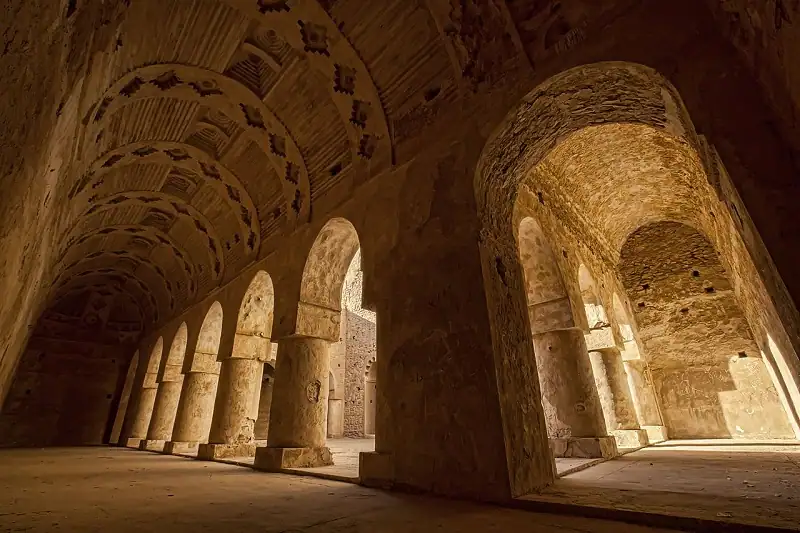Abbasid architecture refers to the architectural style that emerged during the Abbasid dynasty (750-1258 CE) in the Islamic world. This era saw the flourishing of Islamic art and architecture, and the Abbasid architects created some of the most iconic monuments of the Islamic world. Here are some of the major Abbasid monuments that showcase the unique features of this architectural style.

Abbassid architectural contribution
Pier
The pier, which was first introduced in the Great Mosque of Al-Mutawakkil (Samara), revolutionized Islamic architecture and spread through Ibn Tulun Mosque. This innovation was necessary due to the shortage of columns, as Muslim constructions spanned three continents, making transport of columns cost prohibitive. In addition, the development of the pier was motivated by the high cost and effort involved in transportation of columns. It is noteworthy that sources indicate that the first European adoption of the pier was in the beginning of the tenth century, and it was inspired by Ibn Tulun’s innovation.
Pointed Arch
The pointed arch and vault were significant architectural innovations, extensively used in Ukhaidir and other Muslim constructions. The four-centered pointed arch, made of two rings, one inside the other, was a technical breakthrough seen in the Baghdad Gate at Raqqa. It wasn’t until the 11th century that the pointed arch was introduced to Europe, when Amalfitans familiar with Muslim architecture rebuilt Monte Cassimo in Italy.
Helical Minaret
The Al-Malwiya minaret is a unique and iconic structure that represents the Muslim quest for knowledge, which was strongly supported by the Abbassid Caliphs. Its distinctive helical shape is said to symbolize the desire to seek and understand the mysteries of the heavens. This pursuit of knowledge was a key feature of Islamic civilization during this period and manifested itself in various fields such as science, medicine, astronomy, and philosophy. The construction of the Al-Malwiya minaret served as a physical embodiment of this intellectual curiosity and remains a testament to the achievements of the Muslim world in the pursuit of knowledge.
Polilobed Arch
The polilobed form of arches was first introduced in the Abbassid Caliphate, particularly in Samara, and became a prominent feature in North African and Andalusian architecture, adorning many Moorish buildings, most notably the Cordoba Mosque. Since the tenth century, Europeans have been enamored with this style of arch and have adopted it in their own buildings, plans, and art, drawing inspiration from Cordoba’s architectural legacy.
Lobed Rosettes
The extensive use of Umayyad six and eight lobed rosettes, as seen in Figure 7, resulted in their widespread adoption throughout the Muslim world. Later, this ornamental motif made its way to Europe where it was used in the form of six or eight lobed rosette windows, commonly seen decorating the facades of many Christian churches.
Samara Decorative Styles
The decorative styles found in Samara, particularly the use of vegetal forms like vines and abstract geometric patterns, were instrumental in the development of what is now known as Muslim arabesque. Arabesque is a form of artistic decoration consisting of intricate patterns of interlacing lines and geometric shapes that often include floral and plant motifs. This style is commonly seen in Islamic art and architecture, and it can be traced back to the decorative elements used in Samara and other early Islamic structures. The use of these forms and patterns in Samara decoration set the precedent for the development of the highly stylized and intricate arabesque motifs that are still used in Islamic art today.
Abbasid Moques
During the Abbasid era, the construction of mosques took on a new dimension, characterized by their size and unique architectural features. Unlike the Umayyads who primarily used stone construction techniques in their buildings, the Abbasids embraced the Mesopotamian tradition of using mud and baked bricks. These materials were often arranged in decorative ways or carved and molded with geometric and vegetal designs, resulting in highly ornate and intricate structures.
One of the most notable features of Abbasid mosque architecture was the minaret. The minaret, with its monumental size and character, not only served the practical function of calling worshippers to prayer, but also served as a landmark for travelers and advertised the presence of the Friday mosque from afar. The minarets often expressed the prominent role of the mosque in Abbasid society and served as a public display of the Caliph’s power.
Al-Aqsa Mosque
The Abbasids’ earliest major mosque construction project was the rebuilding of Al-Aqsa Mosque. Originally built by Omar, the second Caliph, in 634, the mosque was later extended and improved upon by Umayyad Caliphs, especially Al-Walid. However, it was destroyed by an earthquake in 747-748. The Abbasid Caliph al-Mahdi rebuilt it in 780, and according to Creswell, the mosque has retained its plan to the present day.
Al-Aqsa is the second holiest mosque in Islam after the Kaaba and Medina, and its platform is referenced in the Quran. It is also where the Prophet Muhammad’s ascension took place. The mosque’s central nave led to the Mihrab and was covered by a trussed timber roof. The nave had a width measured by 15 places of worshippers, with 14 aisles on the sides divided by arcades. The major addition by the Abbasids was the arcaded portico in the northern, western, and southern sides, providing protection from the weather and shelter for the poor and travelers.
Another feature introduced by the Abbasids was the unusual T-shaped plan, with the aisles of the sanctuary running parallel to the central nave and intersecting them with the qibla in the Mihrab area. This plan was also adopted in the Quairawan Mosque in Tunisia and later in mosques of Samara. Some suggest that this spatial arrangement may have been derived from the Christian cross plan of the church, but there is little evidence to support this claim, especially considering that the spread of cross and T-shaped churches occurred much later in Romanesque and Gothic Europe.
From Al-Aqsa Mosque to Europe: The Journey of the Pointed Arch
Historical sources suggest that during the First Crusade in 1099, after the fall of Palestine to the Crusaders, the crusading leaders held their first meeting in the Dome of the Rock Mosque. Among those leaders were some who were interested in architecture and could not help but notice the beauty of the pointed arcades in both the Dome of the Rock and Al-Aqsa Mosque.
These leaders brought back this architectural feature with them to Europe when they returned. The pointed arch was a significant departure from the rounded arches that were common in European architecture at the time, and it soon became a hallmark of Gothic architecture. Gothic cathedrals such as Notre-Dame and Chartres in France, and Westminster Abbey and Salisbury Cathedral in England, are known for their use of pointed arches, which allowed for taller and more intricate structures.
The Great Mosque of Samarra
The central mosque of Al-Mutawakkil in Samara was built between 848 and 849 CE during the Abbasid era. The mosque was considered to be the world’s largest at the time, covering an area of 109 acres and containing 25 aisles separated by octagonal piers supporting a teakwood-beamed roof.
One of the unique features of the mosque was the absence of the Mihrab, which was replaced with three arched openings, with the central arch being wider than the rest. The external wall of the mosque was made of baked brick and incorporated semicircular buttresses, decorated with square panels and circular medallions in the center. The mosque also featured a helical minaret known as al-Malwiya, which stood on its own outside the enclosure wall, and had a spiral tower.
The mosque also employed a number of architectural innovations, such as the use of multifoil arches, which were later adopted in Gothic architecture in Europe. The octagonal piers supporting the teakwood beamed roof were also a unique feature, as they were the first recorded instance of this design at least 150 years before its adoption in Europe. The piers had four circular or octagonal marble shafts joined with metal dowels and bell-shaped capitals.
The passage also mentions the Abu Dulaf mosque in Samara, which was built later and adopted many of the features found in the Abbasid plan of Al-Aqsa Mosque. The sanctuary of Abu Dulaf mosque consisted of 17 aisles perpendicular to the Qibla wall and Mihrab, which connected with two naves running parallel to the Qibla and forming the T shape discussed earlier.
Overall, the central mosque of Al-Mutawakkil in Samara was an architectural masterpiece that demonstrated a great deal of ingenuity and innovation. Its unique features and design innovations had a lasting impact on the development of Islamic architecture and were later adopted in other parts of the Muslim world and even in Europe.
Ibn Tulun Mosque
The mosques that followed the Great Mosque of Al-Mutawakkil and the Samara Mosque incorporated the architectural innovations of their predecessors, combining them with new features. Ahmed Ibn Tulun, who was promoted to Emir of Egypt after serving in the troops of Samara, built his mosque in Fustat, Cairo in 876 in a similar style to the Samara mosques. According to Al-Maqrisi, an Egyptian architect designed the mosque, which featured a sanctuary occupying the eastern side of the enclosure with six aisles divided by five arcades of pointed arches carrying the roof. Each arcade was supported by 16 robust piers made of brick, which also appeared in the courtyard, carrying the two arcades of the cloister.
Although the pointed arch had appeared earlier in other structures, such as the Ukhaidir Palace and Alqsa Mosque, Ibn Tulun Mosque was the first recorded example of its systematic use on an extensive scale, at least two and a half centuries before it was introduced to Europe. The mosque also featured an advanced combination of geometrical and floral patterns, known as Arabesque, on the architrave of its arcades, which was the earliest example of such ornamentation, according to Richmond. Later, Arabesque became a prominent theme in most Muslim decorative art.
Other innovations included the introduction of ornamental battlements that crowned the external walls and later became a prototype of Gothic pierced and crested parapets. These motifs were transferred to Europe through the strong links the Fatimids had with Amalfitan and Venetian traders who often visited Cairo and this monument in the 11th century. In summary, Ibn Tulun Mosque was a significant landmark in the development of Islamic architecture and decorative arts and played a vital role in transmitting these innovations to Europe.
Abbasid Palaces
The Ukhaidir Palace, built by Isa ibn Musa between 774-775, was a fortified living complex that contained halls, courtyards, living apartments, and a mosque. It was a masterpiece of architectural innovation that had a long-lasting impact on the development of architecture. The architects and masons of Ukhaidir introduced a new elaborate technique based on the construction of elliptical (pointed) barrel vaults with bricks, which considerably eased the way vaults were built. The old tradition consisted of the use of a mixture of mortar and small stones and debris laid out on a wooden base. The new technique, likely introduced through Persian and Mesopotamian Muslims, provided adequate solutions to these issues.
The Ukhaidir Palace also introduced the first use of pointed arches, which were seen later in Al-Aqsa and other Abbassid buildings. Another original element introduced in Ukhaidir was decorative, consisting of the use of blind arcading, which became an essential element in Muslim architectural decoration and later transmitted to Europe. The appearance of this feature in Ukhaidir some 300 years earlier denies claims by Western scholars that connect the use of blind arcading to Lombard architects, who are considered to be the main builders of Dark ages Europe.
The Ukhaidir Palace also introduced the first fluted dome, which later was adopted in Quairawan mosque. It elaborated the defensive technique found in Raqqa by introducing what’s known as chemin de ronde along the ramparts. The introduction of arrow slits in its walls enabled defence against attackers. Meanwhile, the four gates, consisting each of a chamber with an inner wall and an outer portcullis, provided another defensive architectural technique, again transmitted to Europe through the crusaders.







